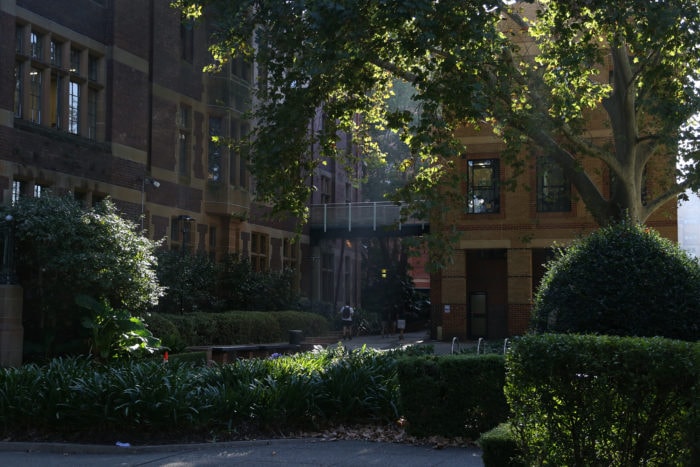Wildlife on campus: University of Sydney

POSITIONED IN THE centre of the city, the University of Sydney may be challenged by its urban surrounds, but it still offers small, hidden pockets of nature, audacious birdlife and an interesting night life – when possums and night owls get active.
It’s perhaps the university’s urbanity that has bolstered a strong community on campus dedicated to promoting the charismatic ibis, bush turkey, magpie, kookaburra, sulphur-crested cockatoo, galah and whatever else can be found.
Iconic birds in front of an iconic building on a great Summer day @Sydney_Uni #nolaughingmatter pic.twitter.com/yWecN7tTIo
— Dieter Hochuli (@dieterhochuli) January 4, 2019
Associate Professor Dieter Hochuli from the School of Life and Environmental Sciences is a big name in urban ecology, particularly in Sydney. His lab at the University of Sydney is decorated with urban ecology stories, including a taxidermied powerful owl – whose species’ mates have recently returned to their Sydney home.

Spotted: a singing magpie. (Image credit: Patrick Wiecks)
Just outside Dieter’s lab, located in the Heydon Laurence building, sits a plump golden orb weaver, which has been a big focus for environmental sciences on campus. “The orb weavers in the city are thriving, mainly because of food availability and the warmth,” Dieter says.
A long walk around campus demonstrates the campuses very European history. “There’s a rich culture in investing in horticulture here. There’s a push for more indigenous plants but there will always be camelias, magnolias and roses. The iconic British garden plants.”
The key to finding a good green, wild space, Dieter explains, all comes down to exploring campus and finding somewhere that you like, rather than spending time in the large park areas.
“There’s nooks and crannies everywhere, with trees, ponds and park chairs,” Dieter says.”You should definitely make the effort to find a quiet green space. I’ve worked here for long enough to understand the challenges of managing your mental health as a student. There’s restorative powers of being outside can be significant contribution to your wellbeing.”

One of the less frequented green spots. (Image credit: Patrick Wiecks)
Plant life on campus
The University of Sydney is home to some iconic Australian plants that tell a unique story about the campus. The most significant of all was, the jacaranda tree (Jacaranda mimosifolia) in the courtyard that fell in early 2016, and has since been replaced.
“People adored the jacaranda and it was really popular during graduations,” Dieter says.”They’d often say that if you hadn’t started studying by the time it started flowering you’re too late, but with climate change it was flowering earlier and earlier.”
Three years ago, the university decided to plant an Illawarra flame tree (Brachychiton acerifolius) alongside the jacaranda to honour the areas indigenous history. Like the jacaranda, the flame tree looks incredible as it blooms its fiery red flowers.
Just outside the famous courtyard is a single Wollemi pine, also known as the ‘dinosaur tree’. Before the species was rediscovered by a rock climber in 1994, it was thought to be long extinct.

The Wollemi Pine. (Image credit: Patrick Wiecks)
Much of the campus, however, is decorated with European species of plant. In 2016, Associate Professor Rosanne Quinnell created Campus Flora, a free app that works a lot like Google Maps but rather than direct you where to go, it tells you what species of plants are around you.
Dieter says that, in comparing aerial images from the 1960s and 1970s to now, the University has definitely improved canopy cover, making it a much greener campus than it was in the early to mid 20th century.
Campus Flora, he says, has gone a long way in making people open their eyes to plants on campus. “Plant blindness, where people don’t tend to notice plants, is a big thing. The diversity of plants and the things they do are not really well known, unless it’s directly pointed out to you.”
Wildlife after dark
According to Dieter, many USYD students would be surprised by the amount of wildlife activity that happens at night. “Students will usually leave campus between five to six o’clock at night, so they miss the possums, owls and other nocturnal animals. It’s quiet and there’s less traffic so the animals feel a lot safer to show themselves.”
“We get foxes, brush turkeys and the range of fruit bats. Microbats are also here, but we know those mainly from audio monitoring.
“In terms of rare things, the body of a long-nosed bandicoot (Perameles nasuta) was found on our tennis courts around 2012 – probably one of the last in the inner west to the best of our knowledge. The population at Dulwich Hill doesn’t seem to be there anymore.”

While these boxes for possums can be seen around campus, Dieter says new research by one of his urban ecology students demonstrates they are not as effective as tree hollows. (Image credit: Patrick Wiecks)
These animals, and even the pests, are relatively well embraced by the university, which has been somewhat of a hub for urban ecology for a long time now. “The urban ecology field used to be treated with a bit of snobbishness by other ecologists and it’s great to see it thriving,” Dieter says. “It’s also a very vibrant field for students, it gives them the capacity to ask important scientific questions about nature and how the world works right on our doorstops.”

